



Introduction
Alopecia areata, also known as spot baldness, is a condition in which hair is lost from some or all areas of the body. Often, it results in a few bald spots on the scalp, each about the size of a coin. Hair loss can be permanent, or temporary. It is distinctive from pattern hair loss, which is common among males.
Causes
Alopecia areata is believed to be an autoimmune disease resulting from a breach in the immune privilege of the hair follicles.
Psychological stress and illness are possible factors in bringing on alopecia areata in individuals at risk, but in most cases there is no obvious trigger. People are generally otherwise healthy.
Alopecia areata is not contagious. It occurs more frequently in people who have affected family members, suggesting heredity may be a factor. In addition, alopecia areata shares genetic risk factors with other autoimmune diseases, including rheumatoid arthritis, type 1 diabetes and celiac disease. Patients also tend to have a slightly higher incidence of conditions related to the immune system, such as asthma, allergies, atopic dermatitis, and hypothyroidism.
Classification
Commonly, alopecia areata involves hair loss in one or more round spots on the scalp.
*Hair may also be lost more diffusely over the whole scalp in which case the condition is called diffuse alopecia areata.
*If the person loses all the hair on the scalp, the disease is then called alopecia areata totalis.
*If all body hair, including pubic hair, is lost, the diagnosis then becomes alopecia areata universalis.
*The disease may be limited only to the beard in which case it is called alopecia areata barbae.
Symptoms and signs
Typical first symptoms of alopecia areata are small bald patches. The underlying skin is unscarred and looks superficially normal. Although these patches can take many shapes, they are usually round or oval. Alopecia areata most often affects the scalp and beard, but may occur on any part of the body with hair. Different areas of the skin may exhibit hair loss and regrowth at the same time. The disease may also go into remission for a time, or may be permanent.
The area of hair loss may tingle or be mildly painful. The hair tends to fall out over a short period of time, with the loss commonly occurring more on one side of the scalp than the other.
Exclamation point hairs, narrower along the length of the strand closer to the base, producing a characteristic "exclamation point" appearance, are often present. These hairs are very short (3–4 mm), and can be seen surrounding the bald patches.
When healthy hair is pulled out, at most a few should come out, and ripped hair should not be distributed evenly across the tugged portion of the scalp. In cases of alopecia areata, hair tends to pull out more easily along the edge of the patch where the follicles are already being attacked by the body's immune system than away from the patch where they are still healthy
Diagnosis
Alopecia areata is usually diagnosed based on clinical features.
Trichoscopy may aid in establishing the diagnosis. In alopecia areata, trichoscopy shows regularly distributed "yellow dots" (hyperkeratotic plugs), small exclamation-mark hairs, and "black dots" (destroyed hairs in the hair follicle opening).
Oftentimes, however, discrete areas of hair loss surrounded by exclamation mark hairs is sufficient for clinical diagnosis of alopecia areata. Sometimes, reddening of the skin, erythema, may also be present in the balding area.
Prognosis
In most cases that begin with a small number of patches of hair loss, hair grows back after a few months to a year. In cases with a greater number of patches, hair can either grow back or progress to alopecia areata totalis.
Hair may grow back and then fall out again later. This may not indicate a recurrence of the condition, but rather a natural cycle of growth-and-shedding. Episodes of alopecia areata before puberty predispose to chronic recurrence of the condition.
Alopecia can be the cause of psychological stress. Because hair loss can lead to significant changes in appearance, individuals with it may experience social phobia, anxiety, and depression.
TREATMENT AT DR. SOHAN LAL CLINIC
The integrated POLYCLINIC facility offers patients to select their treatment either from the Department of Homeopathy or from the Department of Medicine.
We provide scientific, research-based, and professional services to people across the world, aiming to achieve the highest success rate.
